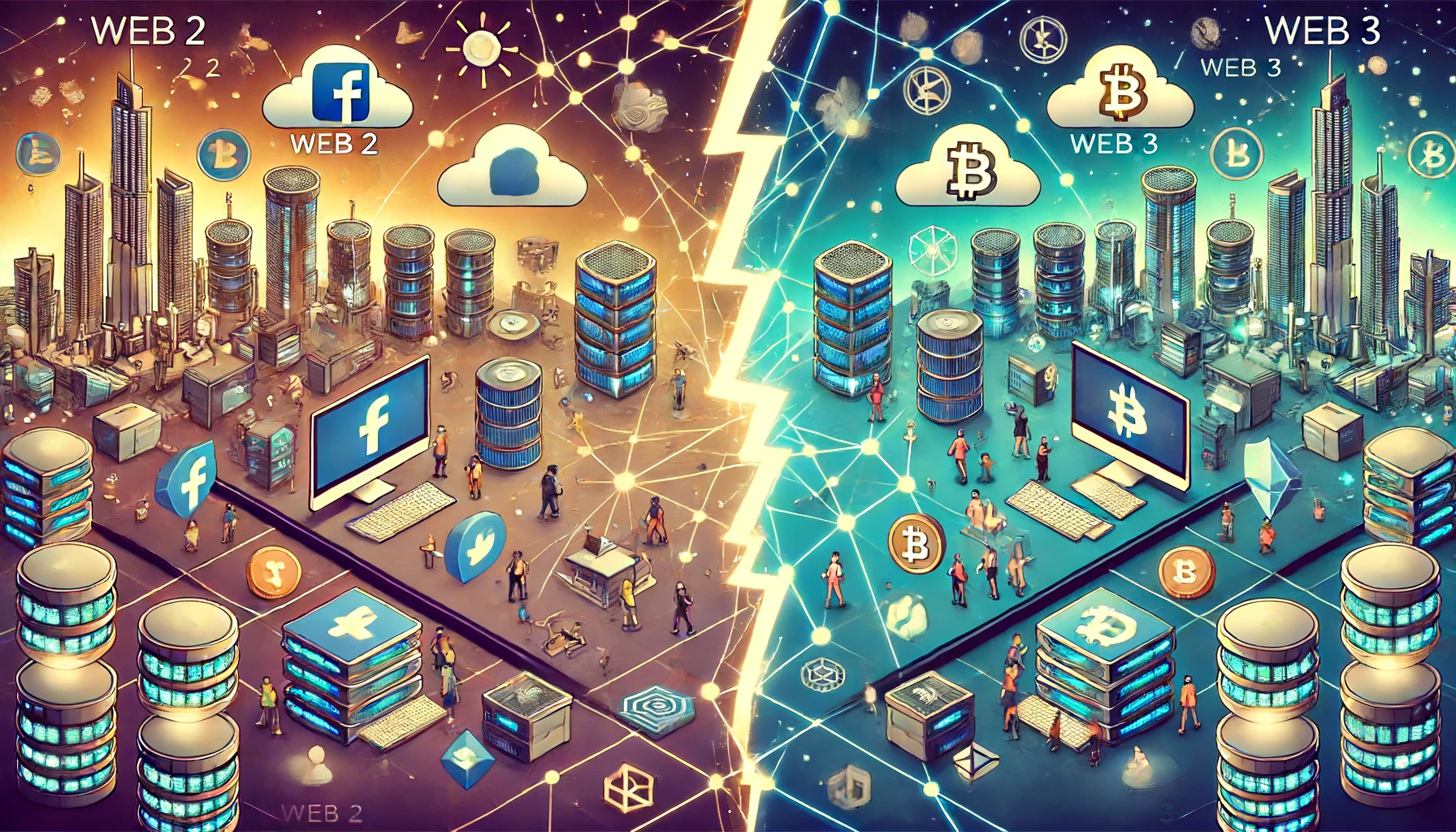Content
- Introduction
- Introduction
- Finance
- Web 2.0
- Web 3.0
- Social Media
- Web 2.0
- Web 3.0
- Content Creation and Distribution
- Web 2.0
- Web 3.0
- Internet Navigation
- Web 2.0
- Web 3.0
- Jobs and the Gig Economy
- Web 2.0
- Web 3.0
- Conclusion
- FAQs
- 1. What is Web 3.0?
- 2. How does Web 3.0 improve financial transactions?
- 3. What are the benefits of decentralized social media?
- 4. How can content creators benefit from Web 3.0?
- 5. What impact will Web 3.0 have on jobs?
- About Zerocap
- DISCLAIMER
19 Jun, 24
Web 2 versus Web 3: Key Differences

- Introduction
- Introduction
- Finance
- Web 2.0
- Web 3.0
- Social Media
- Web 2.0
- Web 3.0
- Content Creation and Distribution
- Web 2.0
- Web 3.0
- Internet Navigation
- Web 2.0
- Web 3.0
- Jobs and the Gig Economy
- Web 2.0
- Web 3.0
- Conclusion
- FAQs
- 1. What is Web 3.0?
- 2. How does Web 3.0 improve financial transactions?
- 3. What are the benefits of decentralized social media?
- 4. How can content creators benefit from Web 3.0?
- 5. What impact will Web 3.0 have on jobs?
- About Zerocap
- DISCLAIMER
The internet has undergone significant transformations since its inception, evolving from static Web 1.0 pages to the dynamic and interactive Web 2.0. Now, we stand at the brink of another major shift with Web 3.0, or Web3, which promises to revolutionize how we interact with digital platforms. This article explores the key differences between Web 2 and Web 3 across various domains, including finance, social media, content, internet navigation, and jobs.
Introduction
Web 2.0, often referred to as the “social web,” brought about a wave of interactivity and user-generated content. Platforms like Facebook, YouTube, and Twitter became central hubs for sharing information and connecting with others. However, Web 2.0’s centralized nature raised concerns over data privacy, censorship, and control by a few tech giants. Web 3.0 aims to address these issues by decentralizing the web, giving users more control over their data and online interactions.


Introduction
Web 2.0, often referred to as the “social web,” brought about a wave of interactivity and user-generated content. Platforms like Facebook, YouTube, and Twitter became central hubs for sharing information and connecting with others. However, Web 2.0’s centralized nature raised concerns over data privacy, censorship, and control by a few tech giants. Web 3.0 aims to address these issues by decentralizing the web, giving users more control over their data and online interactions.
Finance
Web 2.0
In Web 2.0, financial transactions are predominantly managed by centralized entities such as banks, payment processors, and financial institutions. These intermediaries facilitate transactions, ensuring security and trust. However, this centralization also leads to several issues, including high transaction fees, potential censorship, and vulnerability to data breaches.
Web 3.0
Web 3.0 introduces decentralized finance (DeFi), leveraging blockchain technology to enable peer-to-peer transactions without intermediaries. Cryptocurrencies like Bitcoin and Ethereum are native to Web 3.0, allowing for direct, secure, and transparent financial interactions. This decentralization reduces transaction costs, enhances privacy, and eliminates the need for traditional financial gatekeepers. Additionally, smart contracts automate transactions and enforce agreements without human intervention, further increasing efficiency and reducing fraud risks (Algorand Foundation) (NordVPN).
Social Media
Web 2.0
Social media platforms in Web 2.0, such as Facebook, Twitter, and Instagram, operate under centralized control. These platforms dictate content policies, control user data, and can censor or ban users. While they offer powerful tools for communication and community building, they also raise significant privacy and censorship concerns (WoolyPooly) (wix.com).
Web 3.0
Web 3.0 envisions a decentralized approach to social media. Platforms built on blockchain technology, like Mastodon and Steemit, allow users to own and control their data. These decentralized platforms are resistant to censorship, as there is no central authority to dictate terms. Users can freely share content and engage with communities without fear of arbitrary bans or data exploitation (WoolyPooly) (ethereum.org).
Content Creation and Distribution
Web 2.0
Content creation and distribution in Web 2.0 are dominated by platforms like YouTube, Spotify, and Medium. These platforms provide creators with a broad audience but often at the cost of significant revenue sharing and control over content. Monetization is typically ad-driven, and creators are subject to platform policies and algorithms that can affect their visibility and earnings (wix.com) (Investopedia).
Web 3.0
Web 3.0 empowers content creators through decentralized platforms and token economies. Creators can tokenize their work using NFTs (Non-Fungible Tokens), providing new revenue streams and greater control over their intellectual property. Platforms like Audius for music and Mirror for writing allow creators to directly interact with their audience, receive payments in cryptocurrency, and retain ownership of their content. This model reduces dependence on intermediaries and increases transparency and fairness in revenue distribution (Algorand Foundation) (ethereum.org).
Internet Navigation
Web 2.0
Internet navigation in Web 2.0 relies heavily on search engines like Google, which use centralized algorithms to index and rank web pages. While this system is efficient, it also means that a few companies control access to information. This centralization can lead to biased search results and the potential for censorship (NordVPN) (Investopedia).
Web 3.0
Web 3.0 introduces a more decentralized approach to internet navigation. Technologies like blockchain and peer-to-peer networks enable distributed search engines and databases. Projects like The Graph aim to create a decentralized indexing protocol for querying blockchain data, ensuring transparency and reducing the risk of censorship. This shift aims to democratize access to information and enhance user privacy (WoolyPooly) (ethereum.org).
Jobs and the Gig Economy
Web 2.0
The gig economy flourished in the Web 2.0 era, with platforms like Uber, Airbnb, and Fiverr providing new opportunities for freelance work and short-term gigs. However, these platforms operate under centralized control, which can lead to issues such as high commission fees, lack of job security, and limited worker rights (Investopedia) (NordVPN).
Web 3.0
Web 3.0 proposes a decentralized gig economy where workers have more control and autonomy. Decentralized platforms like Gitcoin and Ethlance enable freelancers to find work and get paid in cryptocurrency without intermediaries. Smart contracts ensure fair payment and contract enforcement, enhancing trust between parties. Additionally, decentralized autonomous organizations (DAOs) allow workers to collectively manage and govern platforms, providing more equitable distribution of profits and decision-making power (ethereum.org) (wix.com).
Conclusion
Web 3.0 represents a significant evolution in how we interact with the internet, promising greater decentralization, user control, and transparency. While Web 2.0 brought about unprecedented connectivity and content creation, it also led to centralization issues that Web 3.0 aims to resolve. By leveraging blockchain technology, Web 3.0 introduces new paradigms in finance, social media, content distribution, internet navigation, and the gig economy, potentially transforming the digital landscape.
FAQs
1. What is Web 3.0?
Web 3.0, or Web3, is the next generation of the internet, characterized by decentralization, enhanced user control, and the use of blockchain technology.
2. How does Web 3.0 improve financial transactions?
Web 3.0 utilizes decentralized finance (DeFi) to enable peer-to-peer transactions without intermediaries, reducing costs and increasing security.
3. What are the benefits of decentralized social media?
Decentralized social media platforms offer greater user control over data, resistance to censorship, and the ability to freely share content without centralized oversight.
4. How can content creators benefit from Web 3.0?
Web 3.0 allows content creators to tokenize their work, retain ownership, and monetize directly through decentralized platforms, reducing reliance on intermediaries.
5. What impact will Web 3.0 have on jobs?
Web 3.0 promotes a decentralized gig economy, providing workers with more control, fair payment via smart contracts, and collective platform governance through DAOs.
About Zerocap
Zerocap provides digital asset liquidity and digital asset custodial services to forward-thinking investors and institutions globally. For frictionless access to digital assets with industry-leading security, contact our team at [email protected] or visit our website www.zerocap.com
DISCLAIMER
This material is issued by Zerocap Pty Ltd (Zerocap), a Corporate Authorised Representative (CAR: 001289130) of AFSL 340799. Material covering regulated financial products is issued to you on the basis that you qualify as a “Wholesale Investor” for the purposes of Sections 761GA and 708(10) of the Corporations Act 2001 (Cth) (Sophisticated/Wholesale Client). This material is intended solely for the information of the particular person to whom it was provided by Zerocap and should not be relied upon by any other person. The information contained in this material is general in nature and does not constitute advice, take into account the financial objectives or situation of an investor; nor a recommendation to deal. Any recipients of this material acknowledge and agree that they must conduct and have conducted their own due diligence investigation and have not relied upon any representations of Zerocap, its officers, employees, representatives or associates. Zerocap has not independently verified the information contained in this material. Zerocap assumes no responsibility for updating any information, views or opinions contained in this material or for correcting any error or omission which may become apparent after the material has been issued. Zerocap does not give any warranty as to the accuracy, reliability or completeness of advice or information which is contained in this material. Except insofar as liability under any statute cannot be excluded, Zerocap and its officers, employees, representatives or associates do not accept any liability (whether arising in contract, in tort or negligence or otherwise) for any error or omission in this material or for any resulting loss or damage (whether direct, indirect, consequential or otherwise) suffered by the recipient of this material or any other person. This is a private communication and was not intended for public circulation or publication or for the use of any third party. This material must not be distributed or released in the United States. It may only be provided to persons who are outside the United States and are not acting for the account or benefit of, “US Persons” in connection with transactions that would be “offshore transactions” (as such terms are defined in Regulation S under the U.S. Securities Act of 1933, as amended (the “Securities Act”)). This material does not, and is not intended to, constitute an offer or invitation in the United States, or in any other place or jurisdiction in which, or to any person to whom, it would not be lawful to make such an offer or invitation. If you are not the intended recipient of this material, please notify Zerocap immediately and destroy all copies of this material, whether held in electronic or printed form or otherwise.
Disclosure of Interest: Zerocap, its officers, employees, representatives and associates within the meaning of Chapter 7 of the Corporations Act may receive commissions and management fees from transactions involving securities referred to in this material (which its representatives may directly share) and may from time to time hold interests in the assets referred to in this material. Investors should consider this material as only a single factor in making their investment decision.
Like this article? Share
Latest Insights
Weekly Crypto Market Wrap, 24th June 2024
Download the PDF Zerocap provides digital asset liquidity and digital asset custodial services to forward-thinking investors and institutions globally. For frictionless access to digital assets
What is Alloy? Meet Tether’s Gold-backed Stablecoin
Cryptocurrency has continuously evolved, with various innovations enhancing its use and stability. Tether, one of the most prominent names in the stablecoin market, has introduced
What is the Ethereum Virtual Machine (EVM)?
The Ethereum Virtual Machine (EVM) is a critical component of the Ethereum blockchain, functioning as a decentralised computer that allows developers to create and execute
Receive Our Insights
Subscribe to receive our publications in newsletter format — the best way to stay informed about crypto asset market trends and topics.



 Share
Share  Tweet
Tweet  Post
Post 